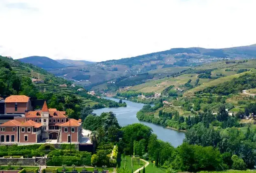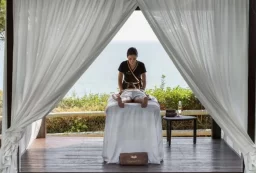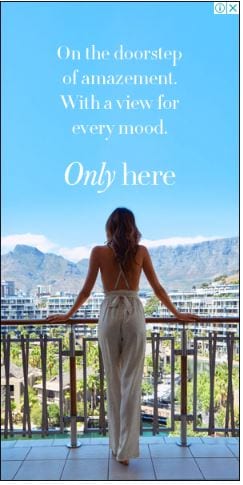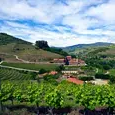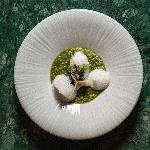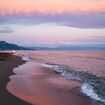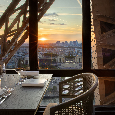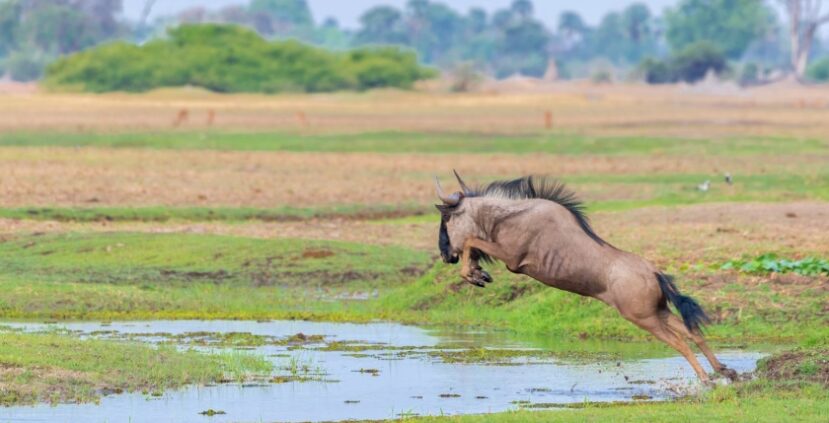
By Nick Walton
“A lioness is living under the bridge at the moment,” says our guide as he slowly manoeuvres the grumbling four-wheel drive onto an expanse of interconnected logs designed to span a sizeable lagoon. At first, I think he’s joking and notions of a lion replacing the proverbial troll come to mind. However, a moment later, there’s a flash of golden fur in the early morning light and a huge lioness elegantly leaps through a gap in the logs onto the bridge. She pauses for a moment to survey our vehicle, the light catching her yellow eyes and white teeth, before leaping down the other side and quickly returning to the shadows beneath us. This is one of the many epic encounters you’ll experience with on a luxury safari in Zimbabwe and Botswana with Wilderness Safaris.

Not only is this a pretty amazing way to start a day here in Okavango Delta, but it’s also an especially rare one; where the lioness and her cubs have made a temporary den is usually a deep, expansive lagoon, but today, as Botswana eagerly waits for the rainy season, it’s gently swaying grasslands.
The Okavango is best known for its complex network of pools, lakes, lagoons, streams and canals, replenished each year by seasonal rains, which make their way to the expansive delta via the Cuito and Cubango Rivers. However, the rains are late this year, very late, and the sun beats down relentlessly on a landscape that is rarely revealed.

My visit to four vastly different Wilderness Safari camps on my luxury safari in Zimbabwe and neighbouring Botswana as the guest of Lightfoot Travel, a global specialist in experiential travel, started the day before at Chitabe, a beautiful little retreat set on a forested private island concession in the southeast of the delta. Here, around a roaring fire on our first night, the sky a breathtaking kaleidoscope of purples, pinks and reds, game guide “OD” Modikwa, a 15 year Wilderness Safaris veteran, tells us about the importance of the seasonal rains on the delta’s landscape and its residents.
“The delta is very different when it’s dry,” he says, adding a log to the fire pit. “It’s still beautiful, it’s always beautiful”, he mused, “but different. Without the rain it can be a hard place for the animals.” He had promised that with low water levels I would see more wildlife, as the herds of elephants, antelope and zebra were able to navigate the grasslands easier, and he was right. Our evening game drive revealed unusual ground hornbills; a pride of three female lions and six incorrigible cubs; shy elephants mingling in corpses of leadwood trees; young giraffes already encrusted with oxpeckers; and a hyena den where curious cubs sniffed the air as they approached.
Chitabe, which was recently re-envisioned by architects Mark Thomas and Chris Bisset, offers travellers access to a cross section of landscapes, ranging from woodlands and wetlands to grassy savannahs that are popular with resident lions and leopards. The home is the where you’ll stay during your luxury safari in Botswana with just eight spacious Meru-styled tents, each raised on wooden decks and linked by an elevated walkway that weaves through the tree line, the camp is a brilliant if not short-lived first stop on my African adventure.
The next day I journey further into the delta and by mid-morning I’ve arrived at Jao Camp, the next stop on my luxury safari in Botswana and a feat of architecture set against riverine forests and vast floodplains. Here, we follow the sassy lioness across what can only be described as “her bridge” to reach the camp.

Jao is home to five spacious tented suites with private plunge pools and outdoor showers, but for a real eye-opener, I’m presented with one of two ultra-lux villas, each of which boasts two bedrooms, cavernous living spaces, and a private jacuzzi on a sprawling deck overlooking the savannah that’s great for beating the mind-dizzying heat. The camp also boasts outdoor boma fire pits and its own spectacular library, which winds around a full-sized giraffe skeleton.

The lack of water is far more obvious at Jao, which is usually an island amidst the floodplains. A pier that’s usually an embarkation point for boat and mokoro canoe excursions now juts out over emerald and gold grass which dances in the mid-day breeze. In front of the camp’s communal swimming pool, the lagoon has drained away and now a huge herd of Cape Buffalo stir up dust eddies as they move, hundreds of swaying heads and rhythmically beating hooves.
There is water of course, but it needs to be discovered first, and MT, Victoria Troskie, one of Lightfoot’s ultra-experienced Africa specialists, and I set off in one of the camp’s game vehicles, racing great swirls of dust as we cross plains of young green grass shoots, bound for one of the watering holes supplemented by Wilderness Safari bore wells.

At the pool, the members of a multi-generational elephant herd take turns to lumber into the clay mud, cooling themselves with great showers of water from their trunks while giraffe, antelope, and warthogs wreath the edge and sip away the relentless afternoon heat. Beyond, a baby baboon sits defiantly atop a termite mound before it spots a circling African fish eagle and scurries for the safety of shady Amarula trees with blood red scars from where elephants have rubbed their tusks.

"By the time we arrive back at the camp, the brooding storm clouds have returned, feeding off the tremendous heat and broiling in the blackened skies above. Finally, with an audible sigh, the heavens open and fat raindrops plummet towards the hot earth, marking the end of the dry season."
Although this is my first visit to Botswana, it’s clear the delta doesn’t usually look like this. Yellow thatch, reddish cotton wool and turpentine grass catches the warm thermals and clutches of termite mounds stand like silhouetted pagodas against the shimmering horizon. Botswana, like its southern Africa neighbours, has experienced the worst drought in decades, and the result can be jarring. The landscape is littered with the carcasses of wildebeest and buffalo, too many for the usually diligent scavengers to keep up with, and the few watering holes have become neutral territory for animals tending to their most basic need.

That afternoon, after creeping up on a young leopard who held court from the bough of a marula tree, his eyes catching every moment without concern, we returned to Jao in time to enjoy dinner under a canopy of stars, within the camp’s traditional bomba, a fortified enclosure designed to keep livestock safe from predators. The wine flows, the music echoes off the beaten earth walls, and the camp staff dance and pray for the rains as their ancestors did for millennia, hands raised to the heavens, feet pounding in the dirt.
The next afternoon I take to the skies with South African pilot Michael Drager on a helicopter game flight over the 15,000sqkm Okavango Delta. He races the Bell 207 helicopter low over great plains that are usually only navigable by boat and from the air it’s easier to see how the waterways that have survived the drought link together like great silver snakes. Clouds drift across the mirrored surfaces of tranquil streams and swampy pools and from above we can spy elephants trudging through the mud, flocks of southern pochards skimming above the surface, Nile crocodiles snoozing among thick reedbeds, and, at one pool, we surprise a trio of rare sitatunga, an antelope that has made watery landscapes its home. It’s a truly spectacular way to explore an equally unforgettable landscape.

From Botswana’s Okavango Delta I journey north to Zimbabwe’s acclaimed Hwange National Park, in the country’s west. The largest natural reserve in Zimbabwe, Hwange, with its mopane woodlands, desert dunes and sparse forests, was founded in 1928 and has had a colourful past, both as a crucial sanctuary for wildlife and as the scene of controversial poaching, including the 2015 killing of Cecil the lion, the reports of which went viral. Companies like Wilderness Safaris have long campaigned to end Zimbabwe’s trophy killing quotas, advocating instead the far-reaching impacts of sustainable tourism through camps like Linkwasha.
Located in a 500sqkm private concession on the edge of the famed Ngamo Plains, Linkwasha is the luxury safari camp in Zimbabwe that offers spectacular year-round game viewing, both from its nine tented suites and on regular walking and game drives that reach far across the undulating landscape in search of wildlife, including an abundance of bird species that ranges from mighty tawny eagles to Dickinson’s kestrels and Bradfield’s hornbills.
Hwange is no stranger to drought, with the vast, bone-dry plains of the Kalahari Desert edging up against the park, but that hasn’t stopped it from becoming a mecca for elephant lovers, as I discover soon after arriving. Our guide Peter, the camp grandfather with 36 years on the job, pauses en route to the camp to watch dozens of elephants arrive and depart one of 14 solar-powered Wilderness Safaris-funded boreholes. There are thought to be 46,000 elephants in Hwange and watching the interactions between the various family units is thrilling.

Of course, at 14,000sqkm, Hwange is also home to a huge cross section of wildlife, from rare African wild dogs (some of the biggest packs in the continent) to lions, leopards, spotted hyena, cheetah, rare gemsbok and brown hyena. During an evening game drive, we trail a pride of lions, including offspring of the great Cecil, whom Peter speaks of fondly, as it makes for another local water source. The lions’ visit to the watering hole, a trickle of bore water at the bottom of a usually deep pool, is interrupted by a family of at least 20 elephants and a tense stand-off ensues, with the lions clinging to their waterside perch for as long as they can before being chased off. As night settles over Hwange, the mournful roars of thirsty lions fill the air.

At Linkshawa, each night sees elephants pass through the middle of the luxury safari camp in Zimbabwe, bound for another shallow pool nearby, and in the warm night air, we gather around the firepit, sipping gin and tonics and listening to Wilderness Safaris’ elephant whisperer Arnold Tshipa talk of the importance of wildlife corridors as huge shadows pass silently beyond on their way to the only water within miles. A couple of intrepid bulls emerge from the inky darkness and sip from the camp’s swimming pool, just feet from where we’re sitting.
It’s important to remember that this parched, wild landscape is also home to people, and I take the opportunity to visit Ngamo Primary, a nearby village school funded in part by Wilderness Safari’s Children in the Wilderness initiative. With principle Moyo and village headman Mr Johnson and his wife Dorothy we visit classrooms, learn about village customs, and see how funding from sustainable tourism companies has helped the school expand from an open-air classroom under a camel thorn tree to 320 students (some of whom walk for miles to reach school) and a dozen teachers.

There’s also time to pay a visit to the Scorpions, an anti-poaching team funded by Wilderness Safaris that works to remove snares and curbs subsistence poaching in cooperation with armed park rangers and local police.
My final stop on this suxury safari adventure in Zimbabwe is northeast of Hwange, where the Manu Pool National Park reaches the mighty Zambezi River and the country’s border with Zambia. Our ancient Cessna soars in over the broad, steadily moving water before touching down on a dirt strip a short drive from camp. The heat here in northwest Zimbabwe is tremendous; the temperature hovers around 40 degrees Celsius during the day and as evening settles, the air becomes alive with frantic, unreleased energy. Great curtains of brooding clouds form on the distant horizon, flashes of lightening streaking the skies, yet there is no reprieve, and no rain to cool the earth below.

Journeying to the camp, we stumble across two African wild dogs panting, snoozing and waiting for the night’s hunt. Their ears catch every sound and as the light drains from the sky above, they quietly rise and trace their way along the riverbank, quickly disappearing in the gloom.
Like the other Wilderness Safari camps, Ruckomenchi is a breathtaking if not remote retreat set beside the great river and looking out to the purple peaks of Zambia’s Rift Valley escarpment. Located in a large private concession in the heart of the Zambezi Valley, the camp boasts just ten spacious tented suites, a blissful plunge pool, an elegantly-appointed lounge, and a popular firepit where guests congregate to share encounters from their game drives and boat safaris on the Zambezi.

During game drives at Ruckomenchi Camp, we explore dried river beds, fields of yellow vetiveria grass, vast desert plains naked of vegetation, and lines of yellow fever trees in which shy elephants retreat from the blazing sun. We encounter greater kudu, Burchell’s zebra, impala, warthog and common waterbuck as well as lions and elephants. Taking to the Zambezi in a camp boat, we approach hippos and crocodiles on the riverbanks and magnificent bird life, including herons, African fish eagles, and beautiful Carmine bee-eaters, which nest in the high earthen banks. After an afternoon spent (unsuccessfully) fishing for tiger fish in the fast flowing river, we let the current take us downstream, and watch as a pair of elephants gingerly cross the waterway as squadrons of Egyptian geese and solo black backed kites swoop across the shimmering water.
By the time we arrive back at the camp, the brooding storm clouds have returned, feeding off the tremendous heat and broiling in the blackened skies above. Finally, with an audible sigh, the heavens open and fat raindrops plummet towards the hot earth, marking the end of the dry season. The rains have finally arrived, and sheltering on the patio of my suite, all I can think of is the hyena cubs, the lumbering young elephants, the prides of thirsty lions and the children of Ngamo, and the relief the rain will bring to this mesmerising destination.

Travel Essentials:
For more information on Luxury Safari in Zimbabwe, Botswana with Wilderness Safari’s camps in go to https://wilderness-safaris.com/
Lightfoot Travel offers an 8-night luxury tailor made Itinerary to South Africa, Botswana, Zambia and Zimbabwe from USD $20,000 per person. This is on a shared basis and includes all safari accommodation on a fully inclusive basis, safari activities, park fees and all light aircraft transfers. For more information visit lightfoottravel.com.






